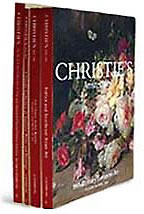The appraiser/dealer then sold the two paintings for $35,000.00 a few weeks later (appraisers should now be thinking conflict of interest and ethical responsibility). After changing hands two more times, the two Dunton's were auctioned for a total of $661,000.00. Yes, that is not a typo, but $661,000.00. Coeur d'Alene Auction sold the MULE DEER BUCK AND DOE (see image) for $402,500.00 and the FISHERMAN IN A STREAM for $258,750.00 during the July 2008 sale.
Now I am a antique furniture dealer and an appraiser. I get many calls where the client says they want an appraisal, but after a minute or two in a discussion about appraisals, it is obvious they actually wish to sell the property to me. I dont know what transpired between the appraiser/dealer and client, but if I am asked to appraise an item, I am upfront and say I will not purchase any property that I appraise. The conflict of interest is rather obvious.
The owner of the paintings sued the appraiser/dealer for fraud and negligence. Last week the verdict was returned with the dealer being found not guilty of fraud, but guilty of negligence and ordered to pay $15,000.00 to the client.
It appears the dealer appraiser knew of the artist, but may not had taken the time for additional research, as the difference in what he claims to sold them for and the final price realized at auction.
This story reinforces why a client for appraisal services needs to select carefully the appraiser. Even if the dealer/appraiser did not buy the two paintings, and instead said they were worth the $35,000.00 he sold them for, he was still negligent in not realizing the true value of the art he was looking at. To me, for not taking the time to select the proper appraiser, the client has lost over a half million dollars. I am sure the $4,500.00 offer sounded very good at the time of offer as the client stated the paintings looked like they were painted by numbers. As this situation clearly indicates, it certainly pays to select the right appraiser, with proper knowledge, experience, research capabilities and ethics. Given what was reported, I am surprised to see the appraiser did in fact belong to a major appraisal association, the Appraisers Association of America (AAA).
This report, along with the recent Dali sales and appraisal at the Houston Salvation Army give appraisers a lot to think about.
KRQE reports
To read the full article, click HERE.Eller paid Hicks $4,500 for the two paintings, one of a fisherman and the other of a buck and doe.
Eller cleaned up the paintings and a few weeks later sold them for $35,000.
The paintings passed hands two more times, and then in July 2008 they sold at auction for more than $661,000.
"Yeah, I was upset," Hicks said.
Hicks said she has theories on why Eller paid her such a small amount of money when experts say they were worth more money.
"He really didn't know what they were worth, and he wanted to move them and figured--what is it?--a fast nickel beats a slow dime," she said. "Or he wanted to move them out of state because he didn't want the possibility of me stumbling into a gallery and seeing them.
"I don't know. I believed option B."
Hicks sued Eller for fraud and negligence. The case went to court last week, and the jury returned a split verdict on Wednesday.
Eller was cleared of fraud but found to be negligent and ordered to pay Hicks nearly $15,000. He declined a request for an on-camera interview but said he was satisfied by the verdict. Hicks said she can live with it, too.
"All we really have is our word," she said. "We give our word. Do we keep our word even if it's not convenient?"
There is also a video on the site which has some scenes from the court case and interviews with the appraiser and client. It is also embedded in the AW Blog post (I dont believe embedded videos are viewable for those getting subscribed to the email delivery service).



